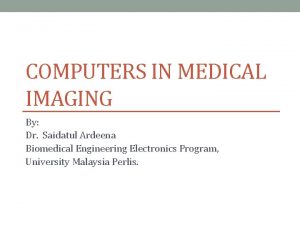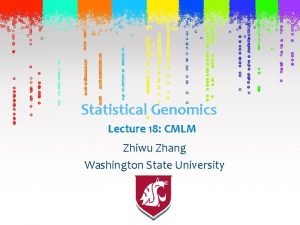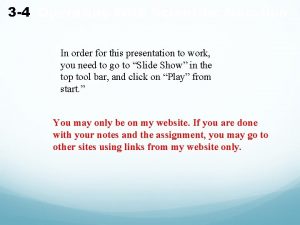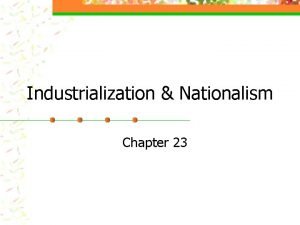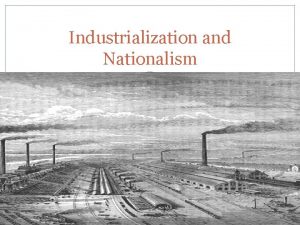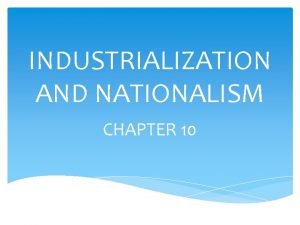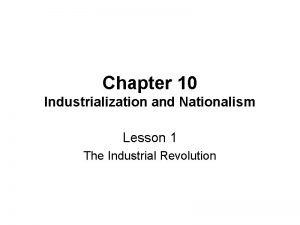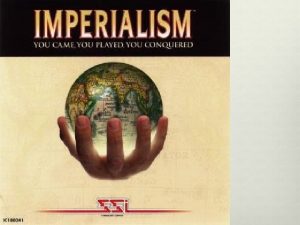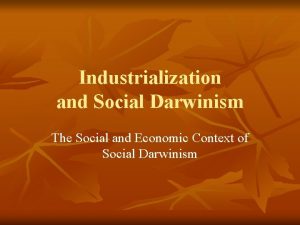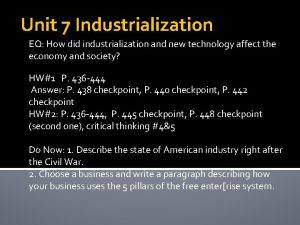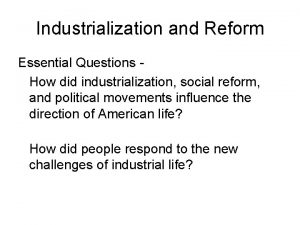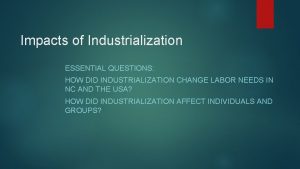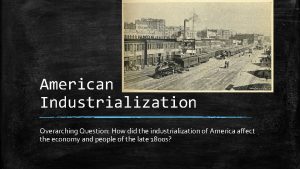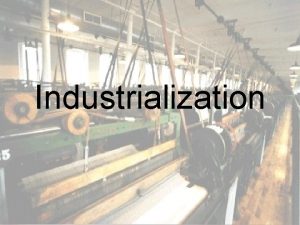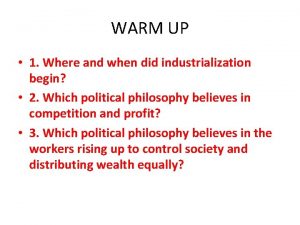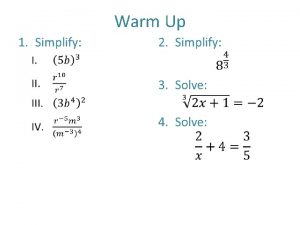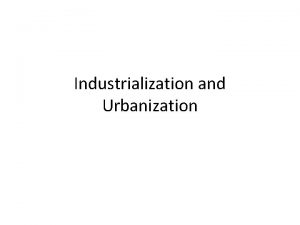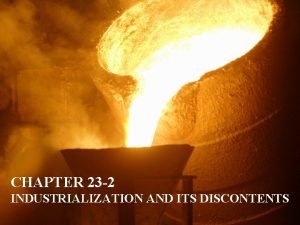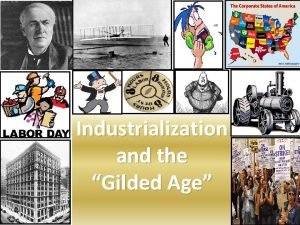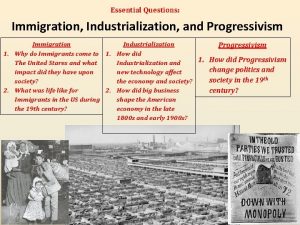Warm Up 1024 How did Industrialization and new



















- Slides: 19

Warm Up 10/24 How did Industrialization and new inventions affect movement and expansion in the United States in the Pre-Civil War era?

Class Business • Due Dates!! • Full credit on due date (turned in or stamped) • -10% each day after up to 50% • ½ credit on test day • Test Day Homework Packets and warmups • NO work from unit accepted after test date

Agenda • Understand the connection between Industrialization, geographic movement, and the American identity • Big Ideas • Manifest Destiny • Migration motivations • Expansion/slavery/politics

Industrialization • Expansion of Market Economy • Specialization in agriculture • Rise of entrepreneurs • Rise of consumers • Mass manufacturing

Expanding Markets • Big inventions connect the country • Telegraph • Canal systems/steamboats • Railroads/steam engines • Steel plows and mechanical reapers • Bigger markets, bigger production

North vs. South • North • Manufacturing/factories • Cities massive immigration • Welcomed commerce/transportation • South • See north as overcrowded and dirty • Embrace agricultural improvements • Slower transportation development

Manifest Destiny “Our manifest destiny to overspread the continent allotted by Providence for the free development of our yearly multiplying millions“ -John L. O’Sullivan

Where are we going?

Motivations • Religious • 2 nd Great Awakening needs somewhere to grow • Build towns around congregations • Preach to Native Americans • Mormon Migration • Head west to avoid religious persecution • Develop trails, bridges, stopping points • Salt Lake – only major city between Mississippi and California/Oregon

Motivations • Economic Opportunity • Santa Fe Trail • Huge market for traders • Establishes presence in New Mexico/Arizona

Motivations • Economic Opportunity • Oregon Country (Not yet territory) • Run by U. S. /Great Britain • Spain and Russia had given up claims • Mostly U. S. settlers • Fertile land access to Pacific trade

54’ 40’ or Fight!

Motivations • Economic Opportunity • Oregon Territory • Polk deems Northern areas unfit for agriculture • Dispute settled at 49 th Parallel

Texas and Southwest • Mexico declares independence in 1821 from Spain • The country of Mexico included present day Texas, California, New Mexico, Colorado, Utah, Arizona, and Nevada • These areas were sparsely populated and Mexico encouraged American immigration. • In 1823, Mexico gives large land grants to Stephen Austin in order to encourage flow of immigrants into Texas.


Texas Tension Builds • Mexico starts to clamp down on immigration • Sets limits on numbers • Forbids slaves from being brought in • By 1830, 000 American settlers in Texas • When Mexican government refused to help settlers with Native American violence, an independence movement forms • The Texas War for Independence begins in 1835

Texan War for Independence = Brutal • 1835 Oct. 2 – Mexican troops attempt to retrieve a cannon that had been given to colonists for protection from Indian attack. The skirmish that ensues is considered the opening battle of the Texas Revolution. • 1835 Nov. 24 – The Texas Rangers organization is officially established by Texas' provisional government. Although Stephen F. Austin had hired 10 frontiersmen as "rangers" to help protect his colonists against Indian raids in 1823, not until 1835 was the law-enforcement group formally organized. • 1836 March 2 – The Texas Declaration of Independence is adopted at Washington-on-the. Brazos. • 1836 March 6 – A 13 -day siege of the Alamo by Mexican troops led by Gen. Antonio López de Santa Anna ends on this day with a battle in which all remaining defenders are killed. (Davey Crockett) • 1836 March 27 – About 350 Texan prisoners, including their commander James Fannin, are executed at Goliad by order of Santa Anna. An estimated 30 Texans escape. • 1836 April 21 – In a battle starting about 4: 30 p. m. and lasting 18 minutes, Texan troops led by Sam Houston defeat the Mexican army commanded by Santa Anna at San Jacinto near present-day Houston reports that 630 Mexican troops were killed and 730 were taken prisoner. Of the Texas troops, nine of a force of 910 were killed or mortally wounded, and 30 were less seriously wounded.

The Republic of Texas • From 1836 until 1845 Texas is an independent nation • Wanted to be annexed immediately by US • US refused in order to avoid conflict with Mexico and slavery debates that would arise • Sam Houston elected first president • Border conflicts with Mexico will continue and eventually lead to the Mexican-American War, as soon as the US annexes Texas.

 262144/1024/1024
262144/1024/1024 1024 x 768 adalah resolusi dari
1024 x 768 adalah resolusi dari Citra yang mempunyai derajat keabuan adalah 1024 termasuk
Citra yang mempunyai derajat keabuan adalah 1024 termasuk 16000/512
16000/512 Begin website
Begin website Chemsheets as 1017 shapes of molecules answers
Chemsheets as 1017 shapes of molecules answers 1024 bytes
1024 bytes 7000/1024
7000/1024 Pb g/mol
Pb g/mol Power notation of 1024
Power notation of 1024 Raiz de 256
Raiz de 256 256 x 1024
256 x 1024 Oberon cisco
Oberon cisco 24*1024
24*1024 Revolution
Revolution Industrialization and nationalism lesson 1
Industrialization and nationalism lesson 1 Chapter 10 industrialization and nationalism
Chapter 10 industrialization and nationalism Industrialization and nationalism lesson 1
Industrialization and nationalism lesson 1 Imperialism and industrialization
Imperialism and industrialization Social darwinism industrial revolution
Social darwinism industrial revolution
